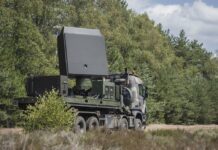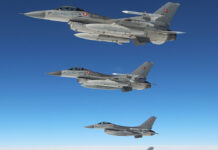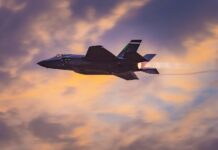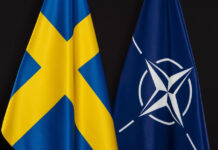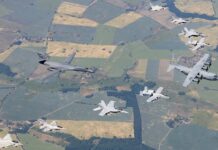So far in 2023, Canada has signed up for some major high-value procurement programmes, while working on existing high-value procurements, and is already laying the groundwork for future major procurements.

Credit: Canadian Armed Forces
In terms of high-value procurement programmes, the Royal Canadian Air Force (RCAF) started 2023 with the announcement that it would be purchasing 88 Lockheed Martin F-35A fighters as the replacement for its aged FA-18 fleet. Then in late June, the US Defense Security Cooperation Agency (DSCA) notified Congress of a possible Foreign Military Sale (FMS) of P-8A Aircraft and related equipment to Canada for an estimated cost of USD 5.9 Bn. This programme would cover the supply of up to 16 Boeing P-8A Maritime Patrol Aircraft (MPA) to replace the current RCAF CP-140 Aurora MPA fleet.
The Royal Canadian Navy (RCN) is in the midst of significant modernisation programmes linked to a National Shipbuilding Procurement Strategy (NSPS). One of the first programmes to get underway was the Arctic and Offshore Patrol Ship Project, which saw the acquisition of six Harry DeWolf class offshore patrol vessels, with three units still to be delivered. The key RCN surface warfare programme is the Canadian Surface Combatant (CSC) that will replace the Halifax class frigates as the primary RCN surface warfare asset. The plan is that a total of 15 CSCs be acquired; clearly this is a high-value procurement programme.
As regards the future, the RCN is looking to make progress with another major programme, namely the Canadian Patrol Submarine Project (CPSP) to replace the four Victoria class conventional submarines (SSK) by the mid-2030s. The Victoria class were originally laid down for the British Royal Navy between February 1983 and March 1990 as the Type 2400 Upholder class. With the end of the Cold War, and reductions in British defence spending, it was decided that an SSK capability was unnecessary, and the mission could be undertaken by nuclear boats (SSN). The programme to build more Upholder SSKs was cancelled, and the four existing boats were taken out of service between April and October 1994.
The idea was to sell the four Upholder vessels to a foreign customer, but that was easier said than done. Meanwhile Canada, which had been flirting with a SSN acquisition to replace its aged Oberon class SSKs, decided to ditch the SSN programme and in 1994 stated that it would negotiate with the British about purchasing the Upholder vessels. It took until April 1998 for the Canadian Government to announce that they were intending to purchase the submarines and eventually a purchase contract was signed in July 1998. The contract included a refit of the SSKs and modifications to meet Canadian requirements.
The SSKs, now renamed as the Victoria class in RCN service, saw three units commissioned between December 2000 and March 2003, with the first becoming operational in June 2005. The final unit, HMCS Chicoutimi (SSK 879), the former HMS Upholder, was on her delivery voyage from Faslane to Canada in October 2004, when a fire broke out aboard. As a result, the SSK returned to Faslane, the damage was assessed, and in April 2005, the SSK was transported to Canada by heavy-lift vessel. Eventually in late April 2009, HMCS Chicoutimi entered refit in Canada, with the work completed in January 2014. After sea trials, the SSK was finally commissioned into the RCN in September 2015.
The RCN CPSP Victoria replacement programme calls for the acquisition of up to 12 new SSKs to be built in Canada. However, there is no real indication that the RCN has been able to persuade the Canadian Government to fully support and fund this acquisition programme at this stage. On the other hand, a programme of this magnitude would certainly fit the intentions of the NSPS and would offer long-term shipbuilding employment and associated economic benefits.
In a Canadian industrial context, preparations are already being made as regards CPSP participation. Babcock Canada, which already has the Victoria class support contract, signed technical cooperation agreements earlier this year with Hanwha Ocean and Hyundai Heavy Industries (HHI) from the Republic of Korea (ROK). Both of these ROK shipyards are involved in the construction of the KSS-III, also referred to as the Dosan Ahn Chang-ho class SSKs for the ROK Navy (ROKN). Prior to this, Babcock Canada signed a Memorandum of Understanding (MoU) with the predecessor of Hanwha Ocean in 2020, covering systems integration collaboration on Canadian vessels.
International Involvement
At the 2016 NATO Summit, it was agreed to deploy multinational battalion-sized battle groups to the Baltic States and Poland. Canada was named as the ‘Framework Nation’ for the NATO enhanced Forward Presence Group (eFP) in Latvia, with the eFP coming under the command of a Canadian Lieutenant Colonel (OF-4). The Latvia eFP was stood up on 19 June 2017 at Ādaži in Latvia, where it works with the Latvian Land Forces Mechanised Brigade. There are some 700 Canadian personnel in the eFP, consisting of a mechanised infantry company, an artillery battery (M777), a combat support company and a combat service support company.
More recently, at the NATO summit in Madrid in June, Canada and Latvia agreed to develop the eFP battle group into a brigade-sized unit. First steps to making that a reality came on 16 June 2023, when Canadian Minister of National Defence Anita Anand announced at the NATO Defence Ministers meeting in Brussels that Canada would deploy 15 Leopard 2 tanks to Latvia as part of the upgrade to a brigade-sized unit.

Credit: Canadian Armed Forces
All of this sounds truly positive, with Canada continuing to modernise its military capabilities through major acquisition programmes for the RCAF and the RCN. Added to this, it is fulfilling its NATO commitments and even increasing its contribution via helping to build the force in Latvia to brigade strength. The problem is that that once you scratch the surface the reality is somewhat different.
The Leopard Issue Emerges
In January 2023, Canada committed to sending Leopard 2A4 tanks from Canadian Forces’ stocks to Ukraine. Initially it was just four tanks on offer, then in February another four tanks had been found for a total of eight. According to the Canadian Government: “An initial allotment of 120 mm ammunition, sourced from existing CAF stocks, will be provided as part of this donation. Donor nations are working together to address sustainment and spare parts.” The question of sustainment and spare parts is important, as there had been suggestions that there were problems in sourcing viable tanks that could be sent to Ukraine. This then led to some Canadian media sources to try and establish what the actual state of the Canadian tank fleet was.
In 2007, Canada purchased 80 surplus Leopard 2A4 tanks from The Netherlands, in addition to purchasing 20 Leopard 2A4 tanks from Germany that would be broken up for spares. Of the 80 ex-Netherlands tanks, 18 would be converted to AEVs, 42 would be used for training and 20 would be upgraded to the Leopard 2A4 CAN configuration. Subsequently Canada would acquire 20 Leopard 2A6 tanks from The Netherlands. According to the official statement from April 2007: “For deployed operations, the Canadian Forces need two combat-ready squadrons of approximately 20 tanks each: one for deployment and a second for rotation into theatre to allow for depot repair and overhaul of the first. An additional two squadrons of 20 tanks each are required for collective and individual training in Canada.”

Credit: Canadian Armed Forces
This all seemed logical as it gave Canada the tank capability it wanted for Afghanistan, allowed them to replace the Leopard C1 tanks that had been in service for 30 years, and demonstrated that Canada was continuing to commit to its international defence obligations. It only became apparent that something was wrong with the picture in 2018, when an article was published by a serving officer studying at the Canadian Forces College. The primary takeaway in the article was the estimate that only 15% to 20% of the Leopard 2 fleet was usable, although that could rise to 30% with some effort.
The cause of this condition, according to the article, was that the maintenance requirements of the Leopard 2 had been massively underestimated. It appears that the maintenance burden estimate was based on experience with the Leopard C1, a significantly simpler vehicle from the earlier Leopard 1 family. Other problems were a shortage of qualified maintenance personnel and the fact that there was no dedicated infrastructure for tank maintenance and overhaul. Then there was a shortage of spare parts to take into account, leading to some tanks being cannibalised for spares.
Another article then appeared from another officer studying at the Canadian Forces College on the subject of tank serviceability in the Canadian Army. The article made it plain that the tank situation had not improved since 2018, with the author describing the cause as a lack of investment in tank sustainment. According to the article, of the 39 tanks supposedly available, only 15 were operational, giving a serviceability rate of around 18% when counted against the entire fleet of 82 tanks.
In 2007, a Canadian tank squadron was described as having 20 tanks, though now the 15 tanks destined for Latvia are described as a squadron. Unless the tank maintenance and serviceability situation in Canada has improved significantly, and there is no real evidence that it has, Canada will be committing all of its functional tank force to Latvia as it will have to rotate the deployment of its two active tank squadrons. All this means they will have to ensure they can have enough available tanks for training in Canada and must accept that they have zero margin for tank deployment to another location internationally.
Meanwhile in Latvia
In early June 2023, some 11 days before Defence Minister Anand announced that Canada would deploy the squadron of 15 Leopard 2 tanks to Latvia, CBC News published an article titled: ‘An ’embarrassing’ gear shortage has Canadian troops in Latvia buying their own helmets’. The article does stray into to hyperbole at certain points, but it also brings to light some significant issues that impact Canadian Forces in the field in Latvia.
The CBC article states: “They’ve been buying their own modern ballistic helmets equipped with built-in hearing protection that doubles as a headset. They’ve also personally purchased rain gear and vests and belts to carry water and ammunition. And the number of complaints about the ill-fitting body armour issued to female soldiers has been growing.”
There is no great surprise that Canadian soldiers are purchasing clothing and load-carrying equipment from commercial suppliers, since you can find better quality commercially than the issued equipment. In response to the article, a Department of National Defence spokesperson stated the work was underway to introduce a new helmet, combat clothing, boots and other equipment in the near future.
Personal kit deficiencies are undoubtedly annoying, but there are bigger problems for the Canadians in Latvia. According to CBC: “Canadian troops in Latvia are grappling with more urgent equipment shortages as well. The battlegroup of roughly 1,500 soldiers, including more than 700 Canadians, lacks modern anti-tank weapons, systems to counter drones and a dedicated short-range air defence system.”
CBC also got hold of an e-mail from Lieutenant Colonel Jesse van Eijk, the Canadian battle group commander in Latvia, who wrote: “In general, it was concerning, verging on embarrassing to see the differences in issued soldier equipment between us and the Danes. This was only exacerbated by the fact they were carrying more advanced Canadian-made Colt Canada rifles, mounting more advanced Canadian Elcan DR sights.”
Canada took the C7 rifle and C8 carbine into service in the 1980s and paired these weapons with the Raytheon Elcan Specter OS (C79) optic. Denmark acquired the C7 as the M/95 and the C8 as the M96, along with the C79 optic in the mid-1990s. Then in 2010, the Danes decided to buy a new rifle, selecting the Colt Canada C8IUR as the Gevaer M/10. The ‘IUR’ designator stands for Integrated Upper Receiver, which includes an integrated rail. Since 2010, Denmark has upgraded the M/10 and in 2020 announced that it would be acquiring the Raytheon Elcan Specter DR 1-4x optic, with first deliveries in 2021.

Credit: Canadian Armed Forces
Canada is actually working towards the acquisition of a new rifle to replace the C7 and C8 in the form of the Canadian Modular Assault Rifle (CMAR) programme, with the rifle to be manufactured by Colt Canada. According to the Canadian Defence Capabilities Blueprint: “The project could deliver a two-tier fleet with Tier 1 Full Spectrum (CMAR-FS) rifles optimised for complex Urban and Open Terrain operations, and Tier 2 General Service (CMAR-GS) rifles designed for common personnel protection. The project could deliver modern modular rifles with suppressors, advanced optics, night vision, grenade launcher and new improved rounds.”
The high-end CMAR-FS would equip infantry units, while the low-end CMAR-GS would equip support units. The CMAR programme is currently in the definition phase, to be followed by the implementation phase, with a target date for initial deliveries being 2026/2027. In parallel, development of a new Canadian 5.56 × 45 mm round is already well underway.
There is a lingering problem though and that appears to be funding. The suggestion is that while the Canadian Army can afford a new weapon, a suppressor and a new Canadian round, advanced optics and night vision might break the budget. Indeed, it seems that, at least initially, CMAR could arrive without an optic, making it arguably less capable than the C7/C8 weapons and C79 optic it is supposed to replace. From the perspective of an outsider, fielding an ‘austere’ CMAR would put Canada into real false economy territory. Taken altogether, it would appear that the Canadian Army is in serious need of additional funding to restore its capabilities.
David Saw




